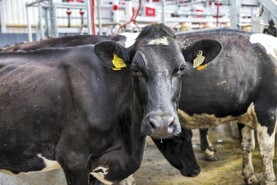We are officially in autumn, which is hard to believe given the terrible weather we’ve had – it feels like we didn’t have a summer at all.
August brought an unusually high amount of rainfall, with our weather station recording 167mm, which is 186% above Castlederg’s long-term average for the month. This made ground conditions difficult throughout the month.
Despite the challenges, the milking herd continued to graze both day and night, although they were restricted to drier fields with multiple access points.
As a result, we grazed lighter grass covers and left heavier covers in wetter fields until the ground conditions improved.
While the immediate impact of the wet weather was clear, we are still feeling its effects. With fields impassable, we couldn’t apply the fertiliser planned after the first week of August, which has hit overall grass growth in September.
Normally in a typical year it is poor ground conditions that force us to house the cows, but this year, I believe a grass shortage will bring them inside sooner than anticipated.
Additionally, many summer tasks, such as drain maintenance and lane work, couldn’t be completed. However, these jobs can still be addressed if there is some decent weather over the winter or early next year.
Calving
Our first cow is due to calve on 1 October, so I am in full preparation mode, getting the calving houses and calf pens ready for the busy season ahead.
Normally, dry cows are grazed behind the milking herd, or on an out-farm, and we bring them in about three weeks before calving to transition them to a silage diet and provide minerals through the feeder wagon. This year, however, we decided to house the cows as they dried off due to the high risk of poaching and the limited grazing areas available.
We still have 18 cows to dry off in the autumn batch, with over 100 cows set to calve in October and November.
Buffer feeding
The spring batch is currently yielding 21 litres per cow per day, with a feeding rate of 0.22 kg of concentrate per litre of milk. The aim is to graze these cows as long as ground conditions and grass supplies allow, with supplemental buffer feeding using silage throughout.
A third cut of silage was finally completed on 7 September.
Although it was a lighter crop than usual and there was some rain during the final hours of collection, I am glad to have all the silage in for winter. Normally, we start buffer feeding in late August or early September, but this year, that process began a month earlier.
With the dry cows in the house sooner than usual, it has impacted our silage supplies. As a result, we are considering alternative feeds, such as soya hulls.
Samples taken from the first and second cuts suggest both cuts of silage are of similar quality, with dry matter at 20.8% and 22.6%, metabolisable energy of 11.6 and 11.5 MJ/kg and 12.9% and 13.2% crude protein, respectively. I am generally satisfied with the energy content; however, the dry matter and crude protein levels are slightly below ideal.
I’m a fairly positive person, although it would be hard to tell with my articles in 2024, but it has been a tough year, with the weather impacting all aspects of farming.
However, with dairy commodities performing strongly, beef prices going up and meal costs slightly easier, hopefully things are on the turn. I suppose, if the youth can’t be positive about the future of farming there is no hope!






 This is a subscriber-only article
This is a subscriber-only article










SHARING OPTIONS: